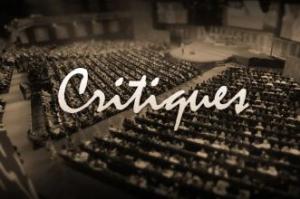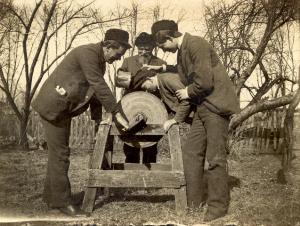 The first time I dared post a story online for critique, I received 38 responses. Since it was my first experience, I didn’t know if that level of response was average or not (turns out it’s not – a dozen is usually a lot). The sheer volume of comments and feedback was overwhelming, totaling more than 100 pages all together. I didn’t know what to do with all the feedback, how to process all the various comments, or even how to get started.
The first time I dared post a story online for critique, I received 38 responses. Since it was my first experience, I didn’t know if that level of response was average or not (turns out it’s not – a dozen is usually a lot). The sheer volume of comments and feedback was overwhelming, totaling more than 100 pages all together. I didn’t know what to do with all the feedback, how to process all the various comments, or even how to get started.
I’ve gone through the critiquing process many times since, and I have gotten much better at making sense of feedback and more importantly, using it to edit, revise, and ultimately, improve a story. Not all critiques are equal, and it’s important to keep in mind that all feedback needs to be considered before acting upon it simply because someone else suggested it.
What I have found to be key is to read the feedback repeatedly over several weeks. It begins as a jumble of thoughts but, with every reading, each comment and suggestion separates itself from the rest. What is unusable drops away and is forgotten, and what is left is what really matters, what can make a difference in your story and make it that much better.
Everyone has their own method for making sense of critiques, and the best one is whatever works for you. My process for dealing with online feedback is detailed below, please feel free to use any part of it that helps develop your own process. The time between each step varies for an unlimited number of reasons, depending on the number of critiques received, the length of the story, how bad the first draft is, etc. Because of a submission deadline, I have on occasion gone through all steps in one day but find that it is best to leave time (days, even weeks) between most of them as it helps absorb all of the feedback and make the most of it.
- Read critiques as they come in: Online critiques are usually submitted under a set period of time (one week, for example) so responses will come in over several days. Just read the feedback, take it all in, and let it cogitate until all the critiques for that project have been received. It’s also good form to send a thank you email to anyone who has taken the time to read your story and send feedback;
- Formatting: From my experience, all feedback is shaped by the critiquer. Everyone has their own style, and no two critiques look the same. Simple things like fonts give more importance to comments that may not be as spot on as the poorly scanned handwritten scrawls on another copy. To me, reformatting all the feedback into a single, uniform document creates a baseline where all of it can be studied without favouring one over another simply because it looks better. Reformatting also gives me the opportunity to read the feedback a second and third time, second when copy and pasting into a single document, third when sifting through it to ensure spacing and everything else is uniform. There are always one or two crits that cannot be reformatted (eg scanned copy of handwritten comments) but I don’t spend any more time than necessary on this step. It’s simply a means to an end. I reformat those that can be copied and pasted into a fresh document, and leave the others as is;
- Mark it up (feedback doc): This is where the real action begins. On a printed copy of the reformatted feedback, I mark the left margin (with a pen) with simple equation signs as I go through the feedback (4th read): specific sections in my story viewed as good (+) or bad (-). I cross off anything that I know for certain cannot be used, either because it isn’t relevant or is contradictory to what I’m trying to achieve. There are always some I don’t know what to make of so I leave those alone for now. On every following read through, I mark or cross off unaddressed comments as I make decisions on them;
- Edit-round one: blind mark-up of the master: I call it a blind edit because I don’t refer to any notes. I set the feedback document aside, and read through a printed clean copy of my story (“master”), noting from memory anything that jumps out in relation to the comments received. I have found that I can address or cover the majority of the feedback through this step. I don’t rewrite yet, I just note what needs to be changed and why (eg POV shift, unclear or repetitive section, contradictory, etc.);
- Edit-round two: all-in mark-up of the master: I retrieve the feedback doc and sift through all the critiques in turn, making anything I missed on the master copy of the story (reading #5) and refer to the original critiques when needed. By this step, many of the comments marked in Step 3 have already been integrated or crossed off. By now, I know where the story needs to go, and what I want it to be in the end. This step is about addressing what I missed during Step 4. For major issues (eg section needing to be entirely rewritten), I note it in the margin to address when I return to the electronic copy. The goal of this step is for all of the retained comments from the feedback doc to have been transferred to the master copy;
- Edit-round three: macro edit (electronic-blind): Back at the computer, I sift through the story again from the start, trying to refer to the marked master copy only when absolutely necessary, instead trying to edit by feel and memory. I know the feedback by now, and I have planned out fairly clearly what needs to be changed. Doing it blind makes it a more organic edit. Even though I call it a macro edit, this is the stage where the most significant rewriting of the story takes place;
- Edit-round four: micro edit (electronic-all in): I go through the story again from the start, still editing and rewriting but this time following along with the marked copy and comparing it to the sometimes vastly different latest draft, incorporating and making use of anything previously missed that is still relevant. Because the drafts of the story are by now so different, many of the comments are now irrelevant (eg structure of a sentence that no longer exists). There are always one or two details that have slipped by the previous step and this fine-tunes the document further;
- Re-read the feedback doc one final time: Set the latest draft aside and re-read the feedback doc. By the end of this final read, anything previously left unmarked should have been either used or discarded. Though it often happens that all has already been covered, it has happened on a few occasions that suggestions left unmarked (or even crossed off) made total sense at this stage. When that happens, I return to the latest draft and incorporate or make use of anything that will help fine-tune a story;
- Final revision: I always try to set aside a story for a few days before tackling the final revision. The feedback is still bouncing in my head and sometimes something I previously dismissed suddenly makes sense and needs to be incorporated even though I thought the story was done. By this stage, it’s unclear how many times exactly I have read the critiques as the feedback has been copied several times and integrated into the various versions. It’s all part of the project, and it’s not necessarily clear what was used exactly as comments from several people on the same issue blend together, and to make it my own I always try to add a twist to it when integrating it into the story. The point is, it’s been used to improve the story and hopefully make it the best version of itself it can be;
- Research markets & submit: What’s the point of doing all this if the story is not submitted? The right market is not always readily available but this Step is a vital part of the process. It’s also great fun to report back to the critiquers to let them know a story they provided feedback on has been published.
Based on genre, there are various online critiques sites available. I am a member of critters.org, which has a substantive forum for speculative fiction.
I look forward to getting your feedback on these steps and how they have helped you develop your own process for dealing with critiques received.
Happy writing.
WWR1441
